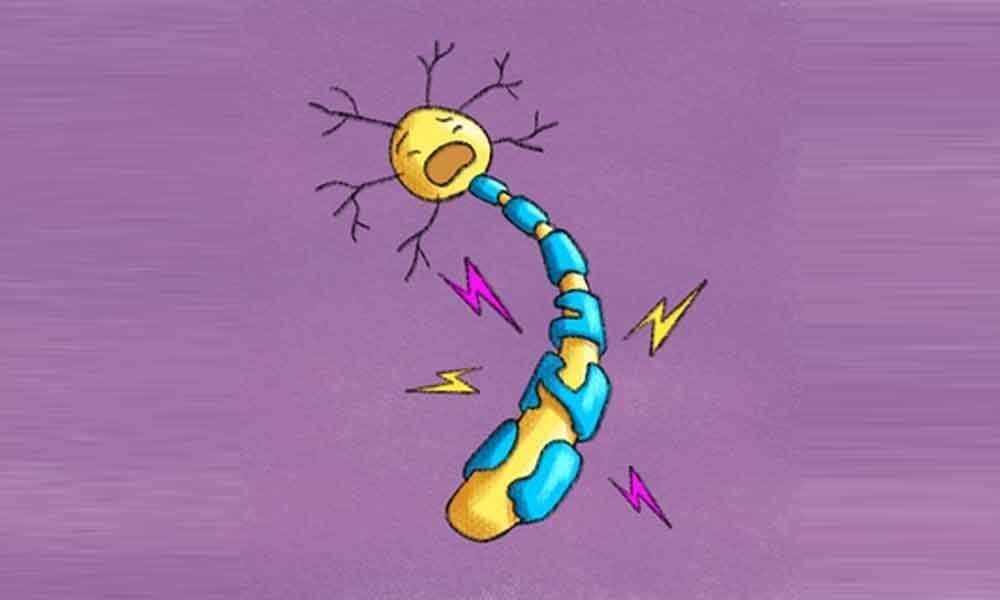Much needs to be done in Indian context

Multiple sclerosis (MS) is a chronic, progressive, degenerative disorder that affects nerve fibers in the brain and spinal cord. A fatty substance (called myelin) surrounds and insulates nerve fibers and facilitates the conduction of nerve impulse transmissions.
Multiple sclerosis (MS) is a chronic, progressive, degenerative disorder that affects nerve fibers in the brain and spinal cord. A fatty substance (called myelin) surrounds and insulates nerve fibers and facilitates the conduction of nerve impulse transmissions.
MS is characterised by intermittent damage to myelin (called demyelination) caused by the destruction of specialized cells (oligodendrocytes) that form the substance. Demyelination causes scarring and hardening (sclerosis) of nerve fibers usually in the spinal cord, brain stem, and optic nerves, which slows nerve impulses and results in weakness, numbness, pain, and vision loss. Because different nerves are affected at different times, MS symptoms often worsen (exacerbate), improve, and develop in different areas of the body.
Early symptoms of the disorder may include vision changes (e.g., blurred vision, blind spots) and muscle weakness. MS can progress steadily or cause acute attacks (exacerbations) followed by partial or complete reduction in symptoms (remission). Most patients with the disease have a normal lifespan.
Types
Multiple sclerosis is classified according to frequency and severity of neurological symptoms, the ability of the CNS to recover, and the accumulation of damage:
- Primary progressive MS causes steady progression of symptoms with few periods of remission.
- Relapsing-Remitting MS causes worsening of symptoms (exacerbations) that occur with increasing frequency, along with periods of reduced symptoms (remission).
- Secondary progressive MS is initially similar to relapsing-remitting MS and eventually progresses to MS with no remission.
- Relapsing-Progressive MS causes accumulative damage during exacerbations and remissions.
Incidence and Prevalence
MS is the most common neurological cause of debilitation in young people and affects about 500,000 people in the United States. Worldwide, the incidence is approximately 0.1%. In India the prevalence, was 10 to 30 cases per 100,000 people.
MS is more common in women and in Caucasians. The average age of onset is between 18 and 35, but the disorder may develop at any age. Children of parents with MS have a higher rate of incidence (30–50%).
Causes
The precise cause of MS is still unknown. Extensive research has shown that both environmental and genetic factors play a significant role. Genetic factors like HLA class II genes, located on chromosome 6 is found to be of special interest. Recently Epstein-Barr virus (EBV) and Vitamin D3 is believed to play a significant role in the pathogenesis of MS.
Diagnosis
There is no single diagnostic test for MS. The diagnosis requires that there should be lesions in the white matter of the CNS, which should be disseminated in time and space and that there should be no other diagnostic possibility. Previously, clinical and laboratory criteria was used but now with advent of MRI the disease can be detected early.
Treatment:
The recent researches and large multinational trials to delay the onset of relapse, reduce the number of relapses and also demonstrate significant benefit on MRIs (used as surrogate marker). The first ones were the β-interferons (three varieties) followed later by glatiramer acetate (all injectable preparations). The introduction of IV Natalizumab in severe cases and in those who do not respond to interferon or glatiramer acetate showed marked benefit. More recently oral agents like Fingolimod, Teriflunomide and dimethyl fumarate have received approval by the drug supervising authorities. Only dimethyl fumarate has been approved and is available in India.
Prognosis
People with multiple sclerosis are believed to have the same life expectancy of those without multiple sclerosis. However, those with severe, progressive forms of MS may have problems caused by the disability may lead to complications such as pneumonia. If patients are not treated, over 30% may develop pronounced problems with mobility. It is not yet known what the long-term outcome of patients who begin treatment at an early stage of their disease will be.
Conclusion
Although we are diagnosing more patients with MS today, much needs to be done in the Indian context. We need greater awareness, more infrastructure facilities especially for rehabilitation, specialised MS clinics in the institutions, MS registry, government support, insurance coverage and availability of effective and affordable disease modifying agents.
(Writer is Consultant Neurologist, KIMS ICON Hospital, Visakhapatnam)
By Dr Ch Vijay







